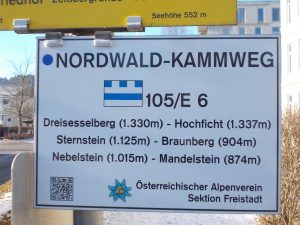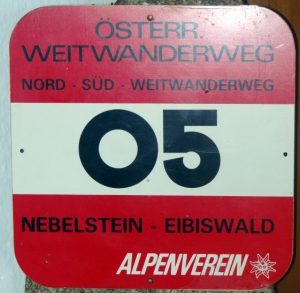Route description
Starting Point in Austria
Dreisesselberg (on the border triangle between Austria, Czech Republic and Germany
End Point in Austria
Radlpass (Border between Austria and Slovenia)
Route of E6 in Austria
Dreisesselberg (border with Germany) – Bad Leonfelden – Freistadt – Sandl – Nebelstein – Liebenau – Ottenschlag – Spitz – Melk – Plankenstein – Mariazell – Hochschwab – Präbichl – Leoben – Mugel – Speikkogel – Gaberl – Pack – Weinebene – Koralpe – Eibiswald – Radlpass/Radelj (border with Slovenia).
Length
620 km
Ground path of E-Path
Nordwaldkammweg: Dreisesselberg – Nebelstein, 141 km
Österreichischer Weitwanderweg 05 („Nord-Süd-Weg“): Nebelstein – Radlpass, 480 km
Responsible organizations
OeAV-Sektion Weitwanderer
Mail: weitwanderer@sektion.alpenverein.at
Web: www.alpenverein.at/weitwanderer
Österreichischer Touristenklub (ÖTK)
Mail: zentrale@oetk.at
Web: www.oetk.at
Naturfreunde Österreich, Touristenverein „Die Naturfreunde“ (TVN)
Mail: info@naturfreunde.at
Web: www.naturfreunde.at Municipal Offices and various local organisations
Publications
SIMON, Gerd: Der Nordwaldkammweg, Verlag Anton Pustet, ISBN 978-3702508609
ÖAV Sektion Weitwanderer: Nord-Süd-Weg – Führer zum Österreichischen Weitwanderweg 05. Order online via www.freytagberndt.com
Maps
These map publishers each cover the whole area:
Marking system
Nordwaldkammweg: Blue and white pattern.

Weitwanderweg 05: Austrian flag along the way, at crossings yellow route indicator signs with name and path number. All path numbers along long distance path no. 05 end with “05”. They usually have a third (regional) digit, e.g. 605.

Crossing with another E-Path
E4, E8 and E10
Practical
Accommodation:
Inns, guesthouses and pensions can be found at least every 20 – 30 km. Both publications listed above are pretty accurate when it comes to names and contact detail of possible places to stay. In the alpine region, several alpine associations maintain mountain huts where you can eat and sleep during summer. Several mountain huts offer (self-supporting) winter accommodation as well, some of them are basic shelters, others are quite comfortable. You can check out the equipment as well as capacity and other important information at:
https://www.alpenverein.at/portal/berg-aktiv/huetten/index.php
Gear:
In the first half of the Austrian part you do not enter alpine territory. Weather-proof hiking equipment will do the trick, you don’t need alpine equipment along the way in Upper and Lower Austria. You reach the Austrian alpine region near the border between Lower Austria and Styria (between Scheibbs and Mariazell). From there on, you will rely on Mountain huts which generally open around May and close at the end of October, respectively. You can check their season window at the link given above.
Food:
In several decentral villages you won’t find a grocery shop anymore, so you rely on your host from time to time. It is usually no problem to buy sandwiches from the breakfast buffet. Usually you have a chance to get warm food once a day.
Travel:
In the northern regions of Austria you will mostly rely on busses. Usually you have a good chance to catch a bus in the morning and around lunch time (school busses). Unfortunately public transportation tends to decrease. Hitchhiking is legal everywhere except on motorways.
——————-
Author: Martin Marktl, Austrian Alpine Association (ÖAV)+

 Walk for unity & wellness!
Walk for unity & wellness! 


